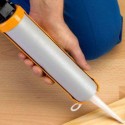Adhesives and sealants are similar in may ways but sometimes they have distinct uses. Sealants are soft when you draw them from their packaging but they harden when they’re applied, to form the seal. A sealant is designed to transfer very little force to the materials it is sealing and is therefore softer than an adhesive. One of the sealant’s main jobs is to prevent water, fire, air or noise from breaking through, in circumstances where ordinary building materials cannot create a serviceable barrier. The other use, in sealant putty for example, is simply as a space filler.

An adhesive is normally a blend of materials that can bond other things. Because industrial adhesives aren’t usually used to fill spaces in this way, they have much more strength than sealants, using harder base materials to spread force onto the supporting structure.
Multiple Products for Different Building Uses
The adhesive itself can take various forms, such as a liquid, gel or a dry powder. Unlike sealants, adhesives frequently need to be set at a certain temperature in order to bond two materials effectively. A great many different kinds of adhesives are used in building work – PVA, epoxy resin, latex, acrylic and polyurethane. They’re used to bond different kinds of materials including flooring, tiles, wood, glass and many others. Sealants have to be more flexible if they’re being used for areas such as skirting boards, where there’s going to be some movement. But again there’s a plethora of products, for roofs, gutters, bathrooms, window frames and other areas.
Combination Sealer Adhesive Available:
It can be very difficult to decide whether an adhesive or a sealant is the right choice. Most professional builders don’t want to buy half a dozen products for each separate job and end up wasting most of each. What they’re looking for is a product that combines the bonding functions of an adhesive with the sealing and filling properties of a sealant, and that can be used on multiple different surfaces and materials. This growing demand has resulted in increased business for companies like Ct1, and prompted a proliferation of new dual function products that are able to work under water, or on wet surfaces.
A combined sealant adhesive may solve the problem of multiple different products, simplifying some building jobs, plus some possible cost and waste reduction.

